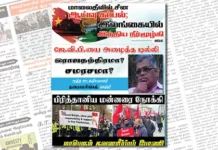It seems that “connectivity” is the buzzword appearing in recent statements on Sri Lanka-India relations. Yet how relevant is it in relation to developments in the world today? In truth, “connectivity” is no longer the positive force that it was thought to be in earlier times when everyone was talking of the promise of globalisation.
On the contrary, today, the very notion of the benefits of connectivity are being questioned the world over, especially by smaller entities living in the shadow of Big Neighbours. Having experienced connectivity through its absorption into the EU, the UK has finally decided through consultation with its people on Brexit, that it is in their national interest to pursue a path independent of the larger European community.
Some smaller entities like Nagorno Karabakh has just had its fate decided by force, viz the sudden military take over accomplished in a few days by Azerbaijan. Was this action inspired by events in Ukraine where Russia has decided to take over certain parts of territory by military force? In both cases, the UN has proved futile, which is not a good sign for other small states which may be experiencing similar territorial dilemmas living alongside larger more powerful states.
Is this the time of might over right? The terrible consequences of the terrorist provocation by Hamas in Israel are still unfolding and pity the hapless population in the Gaza strip now deprived of humanitarian aid, access to power, water and food awaiting the final ground assault by Israel.
Conspiracy theories are afloat suggesting that Israeli leaders had early intelligence warning of a possible Hamas attack and advised, to no avail, to call off the divisive judiciary reforms that had paralyzed that country. So, what part did domestic political exigencies play in this crisis and was the Israeli military takeover of part of Gaza seen by some as a “final solution” to the Palestinian question?
Might over right can be experienced in different ways and not only by armed force. For example, Sri Lanka in its present economic crisis is experiencing a similar shock in the sudden imbalance in its relations with more powerful neighbouring forces which has created a new situation of vulnerability and dependency. For these reasons it is in our national interest to carefully consider the various infrastructural projects being proposed to us under the label of “connectivity”.
A physical bridge between Sri Lanka and India
Probably the most controversial is the notion of a physical bridge between Sri Lanka and India, once touted by Arjuna Mahendran in 2000, it has once again been revived by President Wickremasinghe on his delayed first official visit to India. Sri Lanka’s history and identity as an independent nation has always been linked with its island character and ancient port assets. Was this proposal of a “bridge” a bow to the Indian leaders for the financial assistance extended to Sri Lanka in its present state of bankruptcy?
Whatever the underlying motivation, it has aroused a storm of criticism in Sri Lanka. Letters to the press have conjured up images from the forgotten past of dread disease brought by the importation of indentured labour in colonial times, when entire local villages on the route to the hill country were decimated. Others have raised the spectre of the Tamil Nadu factor, not least because of the assistance that was provided to the LTTE insurrection but also because of fears that our small island would be overrun by the large numbers of population from across the waters.
The Cardinal voiced the opinion reflecting the sentiments of many on the island, that such a proposal would have to be approved by a referendum of the people. Even India, sensing the coming uproar, has been quick to point out that this was a proposal coming from the Sri Lanka side.
The proposal for connecting of power grids between Sri Lanka and India has proved equally controversial particularly after the Express Pearl disaster has shown how little prepared Sri Lanka was to prevent maritime catastrophes. Any such proposal for laying of oil pipelines underwater is fraught with danger from accidental or terrorist strikes.
Moreover, how can the idea of exporting energy from Sri Lanka be realistic when even now the price of domestic power is increasing beyond the reach of ordinary people and the island is still dependent on the main catchment areas receiving sufficient rainfall for hydro power generation?
The examples often quoted of where such energy connectivity already exists between India, with Nepal and Bhutan for example, are on adjoining lands which bear no comparison with the island Sri Lanka. Engineers can propose to build anything anywhere, but have they consulted the people living in those coastal areas and the environmentalists to ensure proper safeguards?
Moreover, how does any right-thinking government justify such costly infrastructural projects when people in Sri Lanka are finding it difficult to make ends meet as poverty levels rising as never before and there is the growing challenge of climate change, more intensive floods, droughts, landslides and even earthquake tremors.
The old suspicions and controversies re-emerging
For those of us who had welcomed the improving relations between India and Sri Lanka nurtured by quiet diplomacy after the end of the armed conflict, it’s a disaster to see the old suspicions and controversies reemerging.
In the long run, should not the emphasis be on building and consolidating people to people connectivity? This can be done not by costly and untimely infrastructural projects but by building Sri Lanka-India relations on an agenda of common values such as the sustainability agenda, education, health, social protection, technology and digitization, safeguarding the environment, wild life and nature, while jointly looking for ways to address climate change.
Without such a central vision, it is the shortcomings of government action which are highlighted daily in the Sri Lanka press and live media. In England, a young vandal who cut down an old historic tree has been arrested; in Sri Lanka the Minister responsible unashamedly justifies his action for cutting down a rare legume tree, even though the tree had received judicial protection, with the result that the ensuing uproar then caused the felled tree to be dug up from where it had been buried!
While our leaders talk of bringing Hindi and Chinese into the school curriculum, private sector leaders are already implementing what is the most essential, the teaching of English through such initiatives as the English Helper project funded by the Indian diaspora for Indian schools, extended to over 1000 local schools in Sri Lanka, reaching 1.2 million students.
The government it seems is out of tune with the needs of the people and faced with the inability of traditional politicians to walk the talk, the initiative has been left to the private sector to lead the change. What implications that will have for the body politic are yet to be seen.
*Dr Sarala Fernando, retired from the Foreign Ministry as Additional Secretary, her last Ambassadorial appointment was as Permanent Representative to the UN and International Organizations in Geneva. Her Ph.D. was on India-Sri Lanka relations, and she writes now on foreign policy, public diplomacy and protection of heritage. [IDN-InDepthNews]
Image source: Lakshman Kadirgamar Institute
Indepthnews.net





